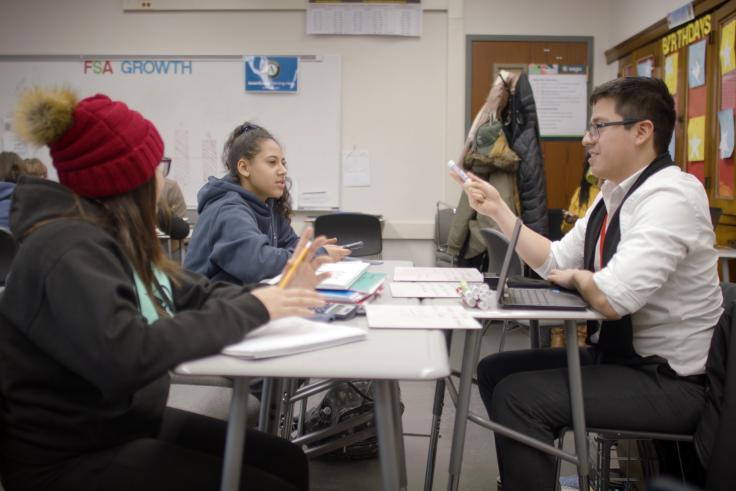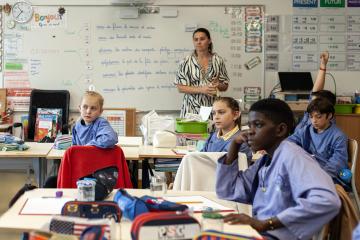Tutoring programs in the United States consistently lead to large improvements in learning outcomes across a range of school grades and educational settings.
Policymakers and donors should expand funding to tutoring programs. Tutoring programs help students overcome achievement gaps and put them on a path to future academic success. Tutoring is one of the few rigorously evaluated interventions in the education field in the United States to show consistently positive impacts across many studies and contexts.
Those implementing tutoring programs should incorporate evidence-based features into program designs. Programs that take place during the school day, involve at least three sessions per week, and pair students with consistent, paid, trained tutors are more effective. Carefully monitoring the implementation of the tutoring program can help ensure it adheres closely to these evidence-based design features.
In the United States, millions of children are behind grade level. Reading test scores are declining nationally, and math test scores are flat or increasing only slightly. When children fall behind early on, it’s harder to succeed later in life: third graders who are not reading proficiently are four times less likely to graduate high school than their peers. Among the many education innovations tried and tested in the United States, tutoring programs are one of the most effective.
The impacts of tutoring programs are strongest for the youngest students. A review of 96 randomized evaluations found that the effects of tutoring programs tended to be strongest among students in earlier grades, though a smaller set of programs at the secondary level were also found to be effective at improving learning outcomes.
Design of tutoring programs makes a difference. Research shows that effective tutoring programs share certain features. One-on-one or small-group tutoring led by professionals, conducted during school hours, and taking place at least three times a week is consistently more effective. The cost and design considerations below elaborate on these important design features.
Cost and design considerations
Tutoring programs are more effective when led by consistent teachers or professional tutors who have been trained and are paid for their work. Professional tutors include school staff members, students in education fields, and fellows who have been trained as part of a formal program. Programs that use these types of tutors (rather than nonprofessional volunteers or parents) are consistently more impactful.
Tutoring programs held during school tend to be more effective than those held after school. A review of 96 randomized evaluations found that during-school programs had twice the impact as after-school programs. This is likely because teachers and program operators can more effectively ensure that tutoring actually happens during the scheduled time, and there may also be fewer distractions.
Students learn the most when they have at least three tutoring sessions a week. Across age groups, students who have three sessions a week consistently learned more than those with one or two sessions a week. The additional time gives tutors a chance to not only cover more material but also develop strong, supportive relationships with students.
Tutoring sessions should be informed by data. Schools and districts can collect data to help tutors identify students’ strengths and learning gaps and tailor tutoring sessions accordingly. Ongoing data collection helps tutors track progress and adjust their approach to better support student learning.
Tutoring programs held during school tend to be more effective than those held after school.
Implementing partners
Implementers bring deep local knowledge, technical expertise, and a commitment to evaluation and learning as they bring these programs to life. Partners include the following collaborators (listed in alphabetical order); this list is not exhaustive.

State and federal government support can play an important role in supporting tutoring programs. In the United States, the Biden administration cited J-PAL North America’s meta-analysis when announcing a national effort to increase access to high-quality tutoring in 2022, and again in 2024 when releasing their Improving Student Achievement Agenda. The US Department of Education officially recommended high-quality tutoring as a strategy to support students in tackling the consequences of Covid learning loss. Many states have also implemented statewide tutoring initiatives and funding. For example, Colorado created the Colorado High-Impact Tutoring Program, and California allocated US$460 million for hiring paraprofessional tutors.
The role of philanthropy
Although federal funding for education can be instrumental, it is increasingly limited and states are struggling to fill the gap. Philanthropy should support state and local education agencies and tutoring organizations to implement high-impact tutoring programs. For example, Accelerate provides funding and research support to tutoring organizations and local education agencies to ensure that tutoring programs are evidence-based and effective.
Evidence on program impact, based on randomized evaluations, has helped catalyze the expansion of tutoring programs to major US urban areas and secure philanthropic funding. For example, Saga Education’s high-dosage, individualized math tutoring model—initially implemented by the charter school network Match Education and rigorously evaluated by J‑PAL affiliated researchers—delivered significant learning gains in Chicago. After strong evaluation results, the program scaled through partnerships with the New York City Mayor’s Office, support from AmeriCorps, and philanthropic funding from the Chan Zuckerberg Initiative, the Laura and John Arnold Foundation, and local Chicago and New York City foundations, expanding into NYC and Washington, DC and serving over 12,000 students.
Discover more from J-PAL
Teaching at the Right Level to accelerate learning
To help students succeed, keep parents informed
Discover more from other sources
Photos:
(1) Credit: Shutterstock.com
(2) Credit: Techonic


